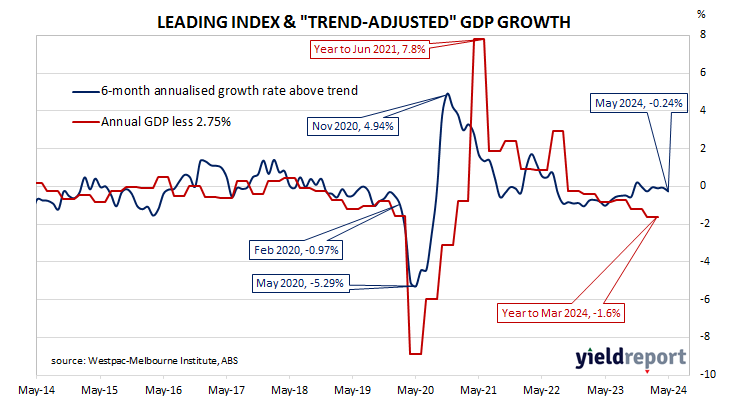Summary: Leading index growth rate down in May; Index points to below-trend growth tracking in second half of 2024, early 2025; reading implies annual GDP growth of around 2.25%-2.50%; ACGB yields jump; rate-rise expectations firm; higher interest rates, reversal of 2023s commodity price gains, difficult conditions in homebuilding sector the main negatives.
Westpac and the Melbourne Institute describe their Leading Index as a composite measure which attempts to estimate the likely pace of Australian economic growth in the short-term. After reaching a peak in early 2018, the index trended lower through 2018 and 2019 before plunging to recessionary levels in the second quarter of 2020. Subsequent readings spiked towards the end of 2020 but then trended lower through 2021 and 2022 before flattening out in 2023.
May’s reading has now been released and the six month annualised growth rate of the indicator registered -0.24%, down from April’s revised figure of -0.05%. The index reading represents a rate relative to “trend” GDP growth, which is generally thought to be around 2.50% to 2.75% per annum in Australia.
“Overall, the Index points to growth tracking slightly below-trend over the second half of 2024 and into early 2025,” said Westpac senior economist Matthew Hassan.
Westpac states the index leads GDP growth by “three to nine months into the future” but the highest correlation between the index and actual GDP figures occurs with a three-month lead. The current reading may therefore be considered to be indicative of an annual GDP growth rate of around 2.25% to 2.50% in the next quarter.
Domestic Treasury bond yields jumped on the day, especially at the short end of the curve, following the release of May CPI figures. By the close of business, the 3-year ACGB yield had gained 18bps to 4.07%, the 10-year yield had added 11bps to 4.32% while the 20-year yield finished 9bps higher at 4.62%.
Expectations regarding rate rises in the next twelve months firmed by the end of the day. In the cash futures market, contracts implied the cash rate would average 4.32% through July, 4.405% in August and 4.47% in November. February 2025 contracts implied 4.44% while May 2025 contracts implied 4.315%, 1bp less than the current cash rate.
“Recent Index reads had suggested momentum was stabilising,” Hassan added. “The lapse back into negative this month gives a much patchier signal. Higher interest rates, an unwind of last year’s commodity price gains and ongoing difficult conditions in Australia’s domestic homebuilding sector have been the main negatives.”
Westpac is currently forecasting GDP growth to be 1.6% in calendar 2024, rising to 2.3% in calendar 2025. The RBA’s May Statement on Monetary Policy also forecasts GDP growth for the years ending December 2024 and December 2025 to be 1.6% and 2.3% respectively.


